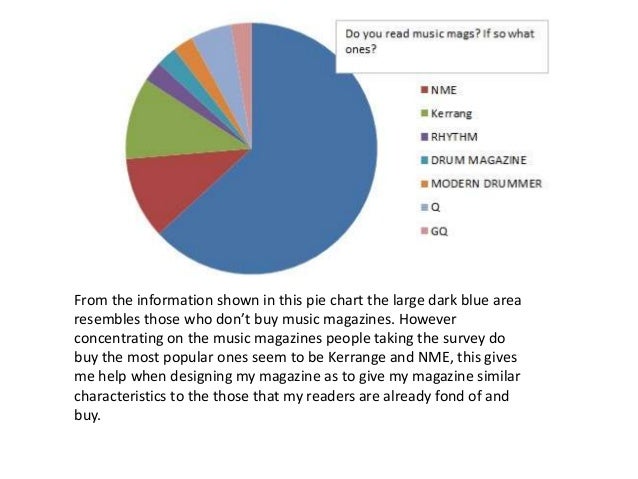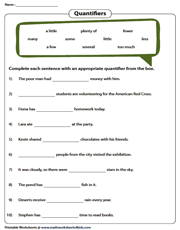- Appear (as this can effect the meaning). RULE 1: If we are using the same quantifier, then the ordering doesn’t matter. Examples. ‘For all x ∈ R and for all y ∈ R, x+y = 4.’, is the same as ‘For all y ∈ R and for all x ∈ R, x+y = 4.’, which is the same as.
- The present study is an attempt to investigate some difficulties that university students of English face when using quantifiers in their written performance. English quantifiers create special.
- 1.2 Quantifiers. Recall that a formula is a statement whose truth value may depend on the values of some variables. For example, is true for x = 4 and false for x = 6. Compare this with the statement. Which is definitely true. The phrase 'for every x ' (sometimes 'for all x ') is called a universal quantifier and is denoted by ∀x.
- Clear Explanation About English Quantifiers Pdf Download
- Clear Explanation About English Quantifiers Pdf File
- Clear Explaination About English Quantifiers Pdf
Quantifiers and Quantification. Quantifier expressions are marks of generality. They come in a variety of syntactic categories in English, but determiners like “all”, “each”, “some”, “many”, “most”, and “few” provide some of the most common examples of quantification. 1 In English, they combine with singular or plural. In English, many noun phrases begin with article s (a,an,the) or demonstratives are the most common types of determiner. English quantifiers (some, all, few, ect.) also function as determiners though in some other languages determiners and quantifiers belong to distinct categories.
Using quantifiers in English - a guide
Part 1
| Click for : | Quantifiers of large quantity | Quantifiers of small quantity | Neutral and relative quantifiers |
Quantifiers are a type of determiner which denote imprecise quantity. They modify nouns or pronouns.
They differ from numbers or numerals which indicate precise quantity.
some / any , much, many, a lot, a few, several, enough.
1. Large quantity quantifiers:
much, many, lots of, plenty of, numerous, a large number of, etc.
► Much and many :
How to unlock itel phone without pc. Much is used with non-count nouns (always in the singular); many is used with ► count nouns in the plural. (See ►the difference between count nouns and non-count nouns). How to change cursor color mac.
Much and many in affirmative statements
In modern spoken English, Much, and to a lesser extent many are not often used as quantifiers in affirmative statements, unless introduced by an intensifier, notably so or too , or followed by of;I have many reasons for thinking that this man is innocent
This is acceptable, but rather formal; most English speakers would more naturally say:
I have plenty of / a lot of / ample / reasons for thinking ...
Much whisky is of very good quality.
This sentence is technically acceptable, but not probable in modern spoken English. Most people would say (and write):
A lot of whisky / A good proportion of whisky / Plenty of whisky ...
He has much money
This is not normal English. Speakers would more naturally say:
He has a lot of money / He has loads of money... etc.
Much of what you have written is very good.
This is quite acceptable in a formal context, but in spoken and less formal written style, most English-speakers would say (and write) something like :
A lot of what you have written... A good deal of what you have written...
There is so much poverty in the world -
There are too many people in here
These examples, with so and too, are perfectly normal English
Much and many in negative statements and questions
Much, and many are more commonly used in interrogative and negative contexts, and most particularly in the interrogative expressions How much and How many.We don't have much time to finish this.
There are not many people who know the answer to this.
Did you have much luck ?
How much does this tee-shirt cost?
How many times do I have to tell you not to do that ?
► Lots of, a lot of, plenty of, a large number of, numerous
These expressions are all more or less synonyms. In the list above, they are arranged in order of formality, going from the most informal (lots of) to the most formal (numerous). Informal language is more appropriate in dialogue, formal language in written documents.For more on style, see ►styles of English .

► Much / many or Much of / many of ?
As quantifiers, much and many are not followed by of when they quantify a noun directly. However they must be followed by of if they come before a determiner such as an article, a possessive or a demonstrative. The same principle applies to few / few of (see below), some / some of, etc.I can't see many people.I can't see many of my friends
Many houses were destroyed in the war.
but Many of the houses were destroyed in the war.
They didn't drink much beer
butThey didn't drink much of that beer we gave them.
► Several and a number of
These imply 'more than one, but less than a lot'. They are not usually used in negative or interrogative structures, only in affirmative statements. For example
2. Small quantity quantifiers:
► few, a few, little, a little, not many, not much, a small number of, etc.
Except for not much or not many, these quantifiers are generally used in affirmative statements.► Little, a little, not muchare used with non-count nouns (always in the singular)
Few, a few, not many are used with count nouns in the plural.
A few and
 a little imply small quantity, but possibly more than expected
a little imply small quantity, but possibly more than expected Few people can speak more than three languages
A few (of the) paintings in this gallery are really good.
There's little point in trying to mend it. You'll never succeed!
I've got a little money left; let's go and have a drink.
There's not much point in waiting for him to come.
3. Neutral and relative quantifiers:
Neutral quantifiers do not indicate either a large quantity or a small quantity: they are not really concerned by actual quantity, only by relative quantity. They are dealt with in four different groups:- ► Some and any (see specific page)
- ► Each and every (see specific page)
- ► All and whole (see specific page)
- Most, most of and enough - See below
Most, most of and enough
There are a couple of common quantifiers that express relative or proportional quantity.► Most / most of
These imply more than half of, a majority of, or almost all . They do not mean the same as many / many of► Enough
Enough implies a sufficient quantity; it is used in affirmations, negations and questions.There were enough strong men to move the fallen tree.
We can get tickets for the concert, I've got enough money now.
NOTE : do not confuse..
enoughClear Explanation About English Quantifiers Pdf Download
as a quantifier adjective preceding a noun, as inwith enough as an intensifier following an ►adjective, as in:
4. Recapitulation: table of usage for common English quantifiers

Clear Explanation About English Quantifiers Pdf File
| Affirmative | Negative | Interrogative | |
| Neutral | some, several, a number of, enough | any, enough | any, enough |
| Large quantity | numerous, plenty of, a lot of, lots of, too many | much, many, too many | much, many, too many |
| Small quantity | few / a few, Little / a little |
► For quantifiers used as pronouns, see Indefinite pronouns, quantifiers & gender-neutral pronouns
4.1. QUANTIFIERS WITH OF.. TAKE CARE:
Much of, many of, few of, a little of, plenty of, lots of, some of, a number of, none of, several of, etc.
When followed by of, some of these quantifiers MUST be followed by an article or other determiner; for others there is a choice (article or no article)| The rule.. | .. applies to |
| MUST be followed by an article or other determiner | all of, each of, some of, many of, much of, (a) few of, (a) little of, none of, several of, enough of, |
| MAY or MAY NOT be followed by an article or other determiner | plenty of, a lot of, lots of, a number of, a couple of, |
Here are a few examples; most are right, some (in grey and barred out) are wrong.
OKSome of the people are right some of the time, but all of the people cannot be right all of the time.
Not OK Some of people are right some of time, but all of people cannot be right all of time.
OK Plenty of supporters came to the match
OK Plenty of the supporters came to the match.
OK Several of the players were sent off.
OK Several players were sent off.
Not OK Several of players were sent off.
OK A couple of players were sent off
OK A couple of the players were sent off.
5. Few or a few, little or a little ?
The difference between the two expressions in each phrase is purely one of meaning, not of usage.Without the article, few and little (used respectively with count nouns and non-count nouns) have the meaning of 'not much/ not many, and possibly less than one might hope for or expect'. These expressions have a negative value to them.
Clear Explaination About English Quantifiers Pdf
 With the article, a few and a little have the meaning of 'at least some, perhaps more than one might expect' . These expressions have a positive value.
With the article, a few and a little have the meaning of 'at least some, perhaps more than one might expect' . These expressions have a positive value. Few of my friends were there, so I was disappointed.
A few of my friends were there, so I was quite happy.
Hurry up; there's little time left !
We have a little time to spare, so let's stop and have a cup of coffee.
Return to English Grammar index